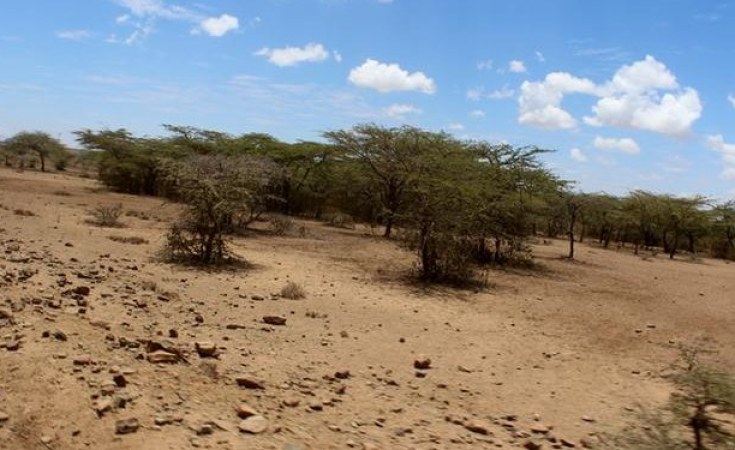Rome — Kaponde Likando does not know how his family will survive until the next farming season. "We are not going to have anything (to harvest)," said the 60-year-old from Chingobe village in southern Zambia after his maize, sorghum, groundnut and sweet potato crops failed. "This has been the very opposite of what we expected."
He is among 9.8 million people in Zambia to have been affected by a severe drought linked to the ongoing effects of the El Niño weather phenomenon.
Likando, who is married and has five children, now faces some grim choices.
"Our hope...we expect maybe to sell some of our animals so we can buy maize for food (consumption)," he said.
Across southern Africa, the current El Niño has dealt a devastating blow to some of the world's hungriest and most fragile communities, where 70% of the population rely on agriculture for their livelihoods
The problem is that once that food runs out, with his livestock gone, there will be nothing standing between his family and starvation.
Likando's plight is not limited to Zambians.
Across southern Africa, the current El Niño has dealt a devastating blow to some of the world's hungriest and most fragile communities, where 70% of the population rely on agriculture for their livelihoods.
From Angola to Zimbabwe, it has left normally fertile soils arid, interrupting the production of staples such as maize, and curtailing people's access to food, as stock dwindle as prices soar.
The three hardest-hit countries - Zambia, Zimbabwe, and Malawi - have declared states of drought disaster. They face widespread crop losses, with between 40% and 80% of their maize harvests decimated.
The United Nations World Food Programme (WFP) says that, across the three countries, nearly five million people need humanitarian assistance.
In the Democratic Republic of Congo (DRC), Kato Kasingabalwa is facing the other extreme of El Niño's impact.
He lost everything, including his maize and rice harvests, in extensive flooding in Uvira, eastern Congo, after torrential rain caused Lake Tanganyika to overflow.
He and his five children have had to move three times to evade the rising water levels and they are living in a makeshift shelter on a vacant piece of land along with many other families whose homes have also been washed away.
Over one million people are estimated to have been impacted by the flooding in DRC, including many who, like Kasingabalwa, have been displaced, while homes, schools, and vast areas of farmland have been destroyed.
"The flooding caught us by surprise," Kasingabalwa said.
"The water level is so high. We have been forced to move to places we could not have imagined settling in. Right now, the family is seriously struggling. Look at the state of my house there.
"I cannot even start describing the state in which my family members are. Some have wounds caused by water infections. The water is full and keeps coming closer to our settlement.
"It is confusing because in the morning, you wake and see the water level go down, but in the evening, the waves from the lake push the water up again, and we rush to move our belongings. This worries us the most..
"I'm a farmer, and all our harvests and seeds were gone."
Although this El Niño cycle is coming to an end, the consequences will continue for months to come.
At an Extraordinary Summit of the Southern African Development Community (SADC) on the current crisis in May, leaders said that 61 million people in the region were impacted by El Niño.
They launched an appeal for US$5.5 billion to meet the urgent humanitarian needs and a UN-led event takes place in Pretoria, South Africa, on June 5 to raise funds for the response.
The meeting was convened by UN Assistant Secretary-General Reena Ghelani, the Climate Crisis Coordinator for the El Niño/La Niña Response, the Office for the Coordination of Humanitarian Affairs (OCHA), WFP, the UN Children's Fund (UNICEF) and the UN Food and Agriculture Organization (FAO) and the UNHCR Office in Pretoria.
El Niño events, which typically occur every two to seven years, have a major influence on temperature and rainfall in many parts of the world, raising the global average temperature and driving extreme weather events including drought, flooding and storms.
It is a natural phenomenon - a disruption of rainfall patterns caused by the warming of surface waters of the eastern Pacific Ocean - although recent studies suggest that global heating may be leading to stronger El Niño events.
Indeed, the most recent El Niño event is one of the five strongest on record.
"Climate change has affected us," Likando said. "Seeing this drought, it's more than in previous years."
WFP says these climate extremes are a reminder of the urgent need to increase investment in activities that build resilience, especially in Southern Africa, so that communities can be empowered with climate adaptation solutions to mitigate, reduce and absorb the effects of such shocks.
WFP anticipated the effects of the El Niño season as soon as predictions were released in 2023, allowing anticipatory action plans and early warning messages to be prepared.
But the UN agency ability's to respond to the emergency and avert a hunger catastrophe has been limited after its appeal for funding went unheeded earlier this year.
"El Niño disproportionately affects women and girls," said Dr Menghestab Haile, WFP Regional Director for Southern Africa.
Haile explained that this is because it is often women who have leave the safety of their homes to go "miles and miles trying to find wood and food," while girls are the first to leave schools to help their mothers.
"We need irrigation," added Hailem who has a PhD in Meteorology.
"Water, water, water - if we'd had the resources to expand irrigation, farmers could produce more food."


